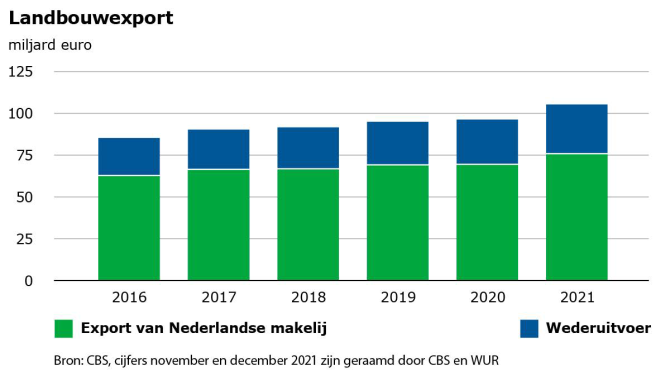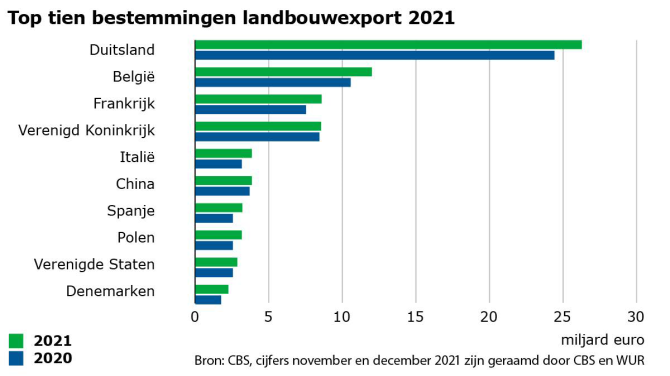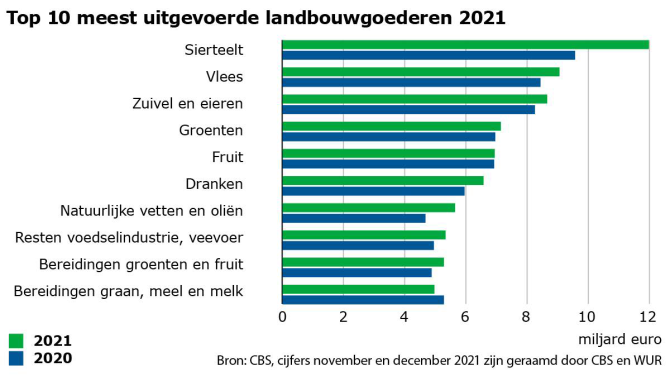
News
Agricultural export in 2021 in excess of 100 billion euros for the first time
The value of agricultural export in 2021 is estimated at 104.7 billion euros, a record. This was reported by Wageningen University & Research (WUR) and Statistics Netherlands (CBS) on the basis of collaborative research commissioned by the Ministry of Agriculture, Nature and Food Quality (LNV).
Agricultural export in 2021 was 9 billion euros (9.4 percent) higher than in 2020. The growth of agricultural export can be attributed to price increases as well as a growth of the export volume. The related price increase was slightly larger than the volume growth. The estimated 104.7 billion euros export of agricultural goods consisted of 75.7 billion euros of goods of Dutch origin and 29.0 billion euros of re-export of foreign agricultural goods. The export of goods of Dutch origin increased by 10.7 percent compared to 2020, re-export increased by 6.1 percent.
In 2021, it is estimated the Dutch economy gained 46.1 billion euros from the export of agricultural goods, which included 42.1 billion euros from the export of goods of Dutch origin and 4.0 billion euro from re-export.

Export mainly to the neighbours
In 2021, a quarter of the agricultural export was destined for Germany (26.3 billion euros). Belgium (12 percent), France and the United Kingdom (8 percent each) were the main destinations after that. France has overtaken the United Kingdom as third-most important destination for Dutch agricultural export. While the value of the export of agricultural goods to France increased by 14 percent in 2021, the export to the United Kingdom barely increased at all (0.4 percent).
35 percent less re-export to the United Kingdom due to Brexit
The export to the United Kingdom is stagnating. This is the result of a substantial decrease in the re-export of agricultural goods of 35 percent. From 1 January 2021, import duties have made it more attractive to transport goods from outside of the European Union directly to the United Kingdom and not by way of the Netherlands. The agricultural export of goods of Dutch origin to the United Kingdom increased significantly in 2021, by 14 percent. However, a factor here is that many British checks on animal and plant products and various customs formalities have been postponed until 2022. It is expected that these checks will impact Dutch agricultural exports to the United Kingdom this year.

Floriculture export increased by 25 percent
As in previous years, floriculture (flowers, plants, flower bulbs, and nursery products) was the most important agricultural export product in euros. In 2021, 12 billion euros of floriculture products were exported, this is an increase of 25 percent compared to 2020. This increase is mainly due to the sharp increase in the price of flowers and plants in 2021. In 2020, the Netherlands exported 9.6 billion euros worth of floriculture, and in 2019 this was 9.5 billion euros.
Meat was the second-most exported agricultural product. Meat export increased by 7 percent, from 8.5 billion euros in 2020 to 9.1 billion euros in 2021. All other key agricultural goods also had an increase in export. Only the export of processed grain, flour, and milk has decreased. One cause was the sharp decline in the export of infant formula to China.

Biological trade
Attention to the circumstances surrounding the creation of traded products is growing. These involve social themes (such as child labour, poor working conditions, slavery) as well as environmental themes (such as climate, biodiversity). The European Commission is expected to publish a guideline in March 2022 that will oblige companies in the European Union to act responsibly. Information about this is scattered throughout the current trade statistics and other statistics. Information about the import of biological goods is available. It shows that 1.5 percent of the total import volume of the European Union was biological in the period 2018-2020. Bananas and animal feed are the largest import streams; Ecuador is the main supply country. Within the European Union, the Netherlands is the main importer of biological products from countries outside the EU.
Comment: Export earnings
The ultimate value of the export to the Dutch economy. This is the export value minus the value of the import required in the whole Dutch production chain to produce this export.
Comment: Agricultural export
Wageningen University & Research, CBS, and the Ministry of Agriculture, Nature, and Food Quality (LNV) have determined, in line with international classifications, which goods are and are not included under the definition of agricultural goods.
Here, the trade in agricultural goods involves the first 24 goods chapters of the international trade statistics, as well as several agricultural goods from the other chapters in accordance with the Combined Nomenclature coding system (GN).
Agricultural goods include unprocessed (primary) agricultural products such as pigs, apples, flowers, flower bulbs, and tomatoes on the one hand, and processed (secondary) products such as cheese, chips, chocolate, beer, tomato ketchup, and fruit juice on the other. The chapters of the GN also determine the definition of the different agricultural goods and are the basis of Figure 3 in this article.
Agriculture-related (tertiary) goods, such as agricultural equipment or fertilisers fall outside of the basic definition of agricultural export but are extensively described in the basic publication (see source).